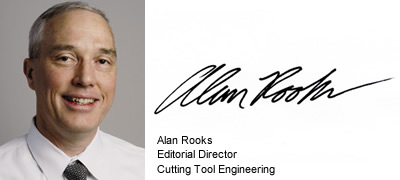Home is where the part is
Home is where the part is
CTE Editorial Director Alan Rooks addresses reshoring in the final Lead Angle column of his 9-year career at Cutting Tool Engineering magazine.
A lot has been written about reshoring in recent years.
Bringing manufacturing operations back to their home country (usually the U.S.) from overseas (usually China) has a patriotic feel to it, and reshoring can also bring back jobs (usually manufacturing ones) as well.
The Reshoring Initiative, Lake Zurich, Ill., led by the indomitable Harry Moser, has been working hard for several years to help companies reshore manufacturing to the U.S. In an April report, the group said more than 60,000 manufacturing jobs were brought to the U.S. by reshoring and foreign direct investment in 2014. With 30,000 to 50,000 jobs being offshored to other countries from the U.S. in 2014, the net gain was at least 10,000 jobs, the group said.
A.T. Kearney, Chicago, a management consulting company, found a different result. Its Reshoring Index indicated that, in aggregate, reshoring in the U.S. dropped by 20 basis points in 2014 compared to 2013, meaning imports of manufactured goods increased faster than exports. However, Kearny did find the top three reshoring industries in the U.S. were electrical equipment, appliances and component manufacturing.
I won't get into the number-crunching debate, but suffice it to say that reshoring is complicated. It's very hard to measure something as complex as global trade. But at least the number of manufacturing jobs in the U.S. is headed upward, after being pummeled during the Great Recession.
I thought about that complexity when working on the cover focus for this issue. At first, the section was going to be about reshoring parts production to the U.S. But one of the articles turned about to be about repatriating parts production from Mexico to the U.S., which is not really reshoring but instead "nearshoring." The other article was about reshoring, but to Canada, even though the company with the Canadian machining operation has headquarters in the U.S. But that doesn't alter the fact that both operations brought production back home. I hope you enjoy the articles.
As it turns out, those articles were among the last I will work on as editorial director of CTE because I've accepted a new job outside the industry. I've enjoyed my 9-year tenure here, having seen firsthand the remarkable vitality of the metalworking industry and the passion of the people who have made it their life work. At CTE, we focus mostly on how parts are made, but we also try to capture the ingenuity and spirit of the people who make them. One of the things I've enjoyed most is meeting the people, be they at machine shops or suppliers, who collectively move our industry forward. Thanks for providing us with the great information and stories we use to create CTE each month.
I'd also like to offer a special thanks to John and Jackie Roberts, the owners of CTE, and Don Nelson, publisher, who gave me the opportunity to lead the editorial operations and encouraged me along the way. It's been a great—and unforgettable—part of my career. Also, thanks to our team of editors, salesmen, office staff and freelance writers who do an outstanding job of producing CTE. To my friends in the industry, thanks for your hospitality, and to the readers of CTE, thanks for inviting us into your shops and homes every month. I hope our paths will cross again someday. CTE


